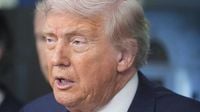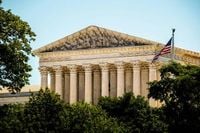On August 25, 2025, President Donald Trump signed a controversial executive order targeting those who burn the American flag as an act of protest, reigniting a long-standing debate over free speech, patriotism, and the limits of government power. The move came against a backdrop of national turmoil, including a deadly mass shooting at a Catholic church in Minneapolis and heated disputes within federal health agencies. But it was the flag-burning order that quickly took center stage, drawing sharp reactions across the political spectrum and setting the stage for a potential legal showdown over the First Amendment.
Just days after the executive order was signed, a dramatic scene unfolded outside the White House. A U.S. military veteran, megaphone in hand, set an American flag ablaze at his feet. As the flames rose, the veteran declared, “I am a 20-year veteran of the United States Army. It is our First Amendment right to burn this flag, regardless of what the president says,” according to Fox News. The protest, captured on video, quickly went viral and became a flashpoint for the broader debate. Another man approached the veteran, but the veteran stood his ground, repeatedly stating, “get away from me.”
Authorities soon intervened, taking the veteran into custody in what is likely to become a test case for Trump’s order. The timing was no coincidence: the protest was a direct response to the president’s directive, which had instructed Attorney General Pam Bondi to prosecute flag desecration cases and pursue new legal challenges to the Supreme Court’s 1989 decision in Texas v. Johnson. That landmark case established that flag burning is a form of symbolic speech protected by the First Amendment.
Trump’s executive order was clear in its intent. It called for the attorney general to “prosecute those who desecrate this symbol of our freedom, identity, and strength to the fullest extent permissible.” The president was even more forceful in his public remarks, telling reporters, “if you burn a flag, you get one year in jail, no early exits, no nothing.”
The order quickly sparked a firestorm of commentary, especially among conservatives who otherwise count themselves as staunch supporters of the flag. On social media, conservative radio host Jesse Kelly wrote, “I would never in a million years harm the American flag. But a president telling me I can’t has me as close as I’ll ever be to lighting one on fire. I am a free American citizen. And if I ever feel like torching one, I will. This is garbage.” Fellow commentator Dana Loesch echoed those sentiments, stating, “Flag burning is vile but the government has no right to control speech or expression.”
The Supreme Court’s ruling in Texas v. Johnson has long been a touchstone in the debate over symbolic speech. In that case, the Court ruled by a narrow margin that burning the American flag is protected under the First Amendment. The late Justice Antonin Scalia, known for his conservative views, was among the majority. In a 2012 interview with CNN, Scalia explained his reasoning: “If I were king, I would not allow people to go about burning the American flag. However, we have a First Amendment, which says that the right of free speech ‘shall not be abridged.’ And it is addressed, in particular, to speech critical of the government. I mean, that was the main kind of speech that tyrants would seek to suppress.” Scalia went on to clarify, “Burning the flag is a form of expression. Speech doesn’t just mean written words or oral words. It could be semaphore. And burning a flag is a symbol that expresses an idea, ‘I hate the government, the government is unjust,’ whatever.”
Vice President JD Vance weighed in on the controversy, arguing that the executive order was “consistent with Texas v. Johnson,” but also stating that the case was wrongly decided. This nuanced position reflects a broader tension within the conservative movement: a deep reverence for the flag, but also an abiding respect for constitutional freedoms, even when they protect unpopular forms of protest.
The executive order did not emerge in a vacuum. In recent months, flag burning has become a frequent feature of anti-Israel and anti-ICE demonstrations across the country, fueling calls from some quarters for a tougher government response. Trump’s order was in many ways a reaction to these protests, as well as a signal to his political base that he would defend national symbols against perceived desecration.
Yet the backlash was immediate and bipartisan. Legal experts and civil libertarians pointed out that any attempt to criminalize flag burning would run headlong into established Supreme Court precedent. As noted by The Economic Times, the 1989 decision in Texas v. Johnson remains the law of the land, and any effort to overturn it would require a new test case and, potentially, a reexamination by the current Court.
The legal implications are significant. Trump’s executive order directs the Justice Department to seek litigation that could challenge or even redefine the boundaries of First Amendment protections. Whether the courts will entertain such a challenge remains to be seen, but the arrest of the veteran outside the White House could provide the spark for a new round of legal battles.
Meanwhile, the nation continued to reel from tragedy. On August 27, a mass shooting at Annunciation Catholic Church in Minneapolis left two children dead and 17 others wounded during a school Mass. In response, Trump ordered flags at U.S. military bases and embassies to be flown at half-staff. FBI Director Kash Patel announced that the bureau would investigate the shooting as both an act of domestic terrorism and a hate crime targeting Catholics. The alleged shooter, identified as Robin Westman, was taken into custody. Lawmakers, including Sen. Tammy Baldwin, called for new legislative action to address gun violence, with proposals ranging from universal background checks to a ban on assault weapons—a policy long advocated by the U.S. Conference of Catholic Bishops.
As these multiple crises unfolded, the Trump administration also faced internal upheaval. The White House fired CDC director Susan Monarez after disagreements over vaccine policy with Health and Human Services Secretary Robert F. Kennedy Jr., a prominent vaccine skeptic. Several other CDC officials resigned in protest, and Jim O’Neill, a Kennedy ally, was named acting director. The policy dispute centered on new FDA restrictions limiting updated COVID-19 vaccines to those most at risk, such as seniors and people with chronic health conditions. The Catholic Church reiterated its stance that vaccination should be voluntary but morally permissible to protect the common good, provided ethically acceptable options are available.
In a nation already on edge, the flag-burning order has become a lightning rod for deeper questions about freedom, dissent, and the meaning of patriotism. As the courts prepare to weigh in, and as Americans continue to grapple with violence and division, the debate over the flag—and the rights it represents—shows no sign of fading.





